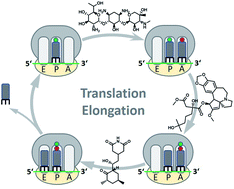Natural products targeting the elongation phase of eukaryotic protein biosynthesis
Abstract
Covering: 2000 to 2020
The translation of mRNA into proteins is a precisely regulated, complex process that can be divided into three main stages, i.e. initiation, elongation, termination, and recycling. This contribution is intended to highlight how natural products interfere with the elongation phase of eukaryotic protein biosynthesis. Cycloheximide, isolated from Streptomyces griseus, has long been the prototype inhibitor of eukaryotic translation elongation. In the last three decades, a variety of natural products from different origins were discovered to also address the elongation step in different manners, including interference with the elongation factors eEF1 and eEF2 as well as binding to A-, P- or E-sites of the ribosome itself. Recent advances in the crystallization of the ribosomal machinery together with natural product inhibitors allowed characterizing similarities as well as differences in their mode of action. Since aberrations in protein synthesis are commonly observed in tumors, and malfunction or overexpression of translation factors can cause cellular transformation, the protein synthesis machinery has been realized as an attractive target for anticancer drugs. The therapeutic use of the first natural products that reached market approval, plitidepsin (Aplidin®) and homoharringtonine (Synribo®), will be introduced. In addition, we will highlight two other potential indications for translation elongation inhibitors, i.e. viral infections and genetic disorders caused by premature termination of translation.

- This article is part of the themed collection: Targeting and extending the eukaryotic druggable genome with natural products


 Please wait while we load your content...
Please wait while we load your content...